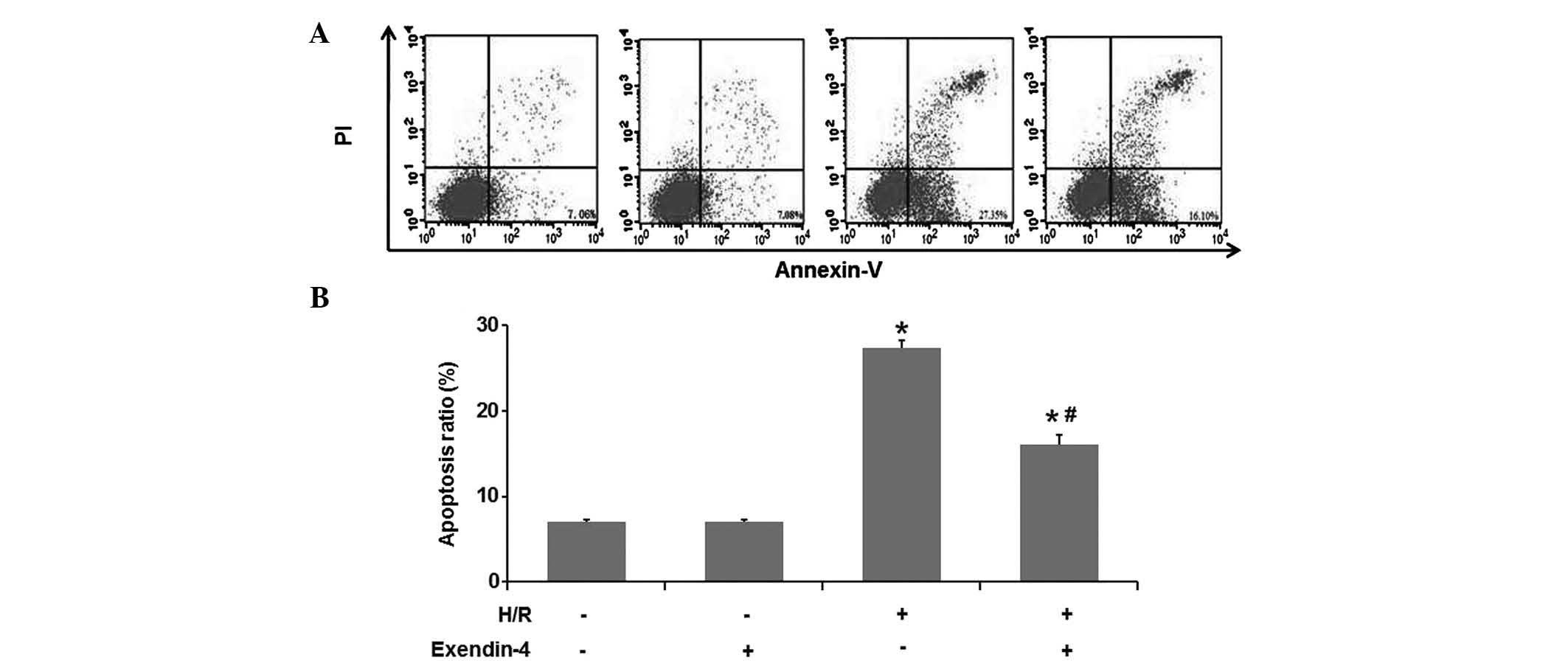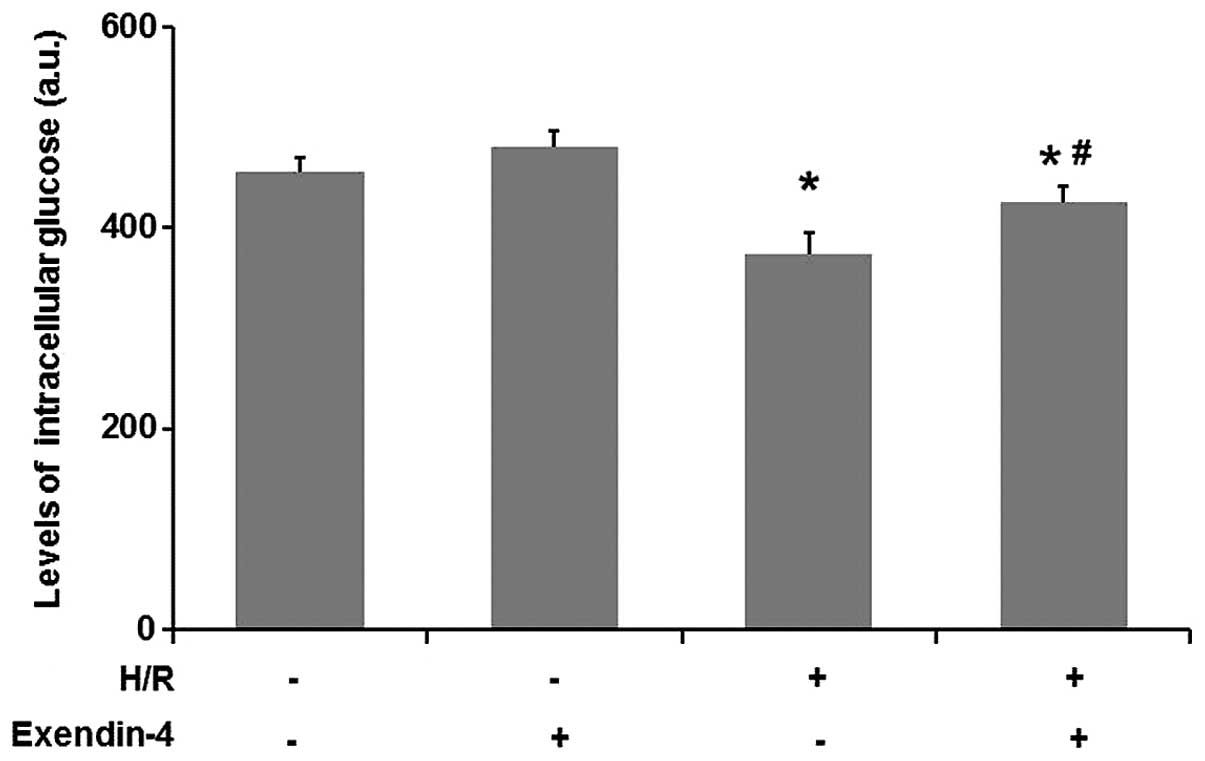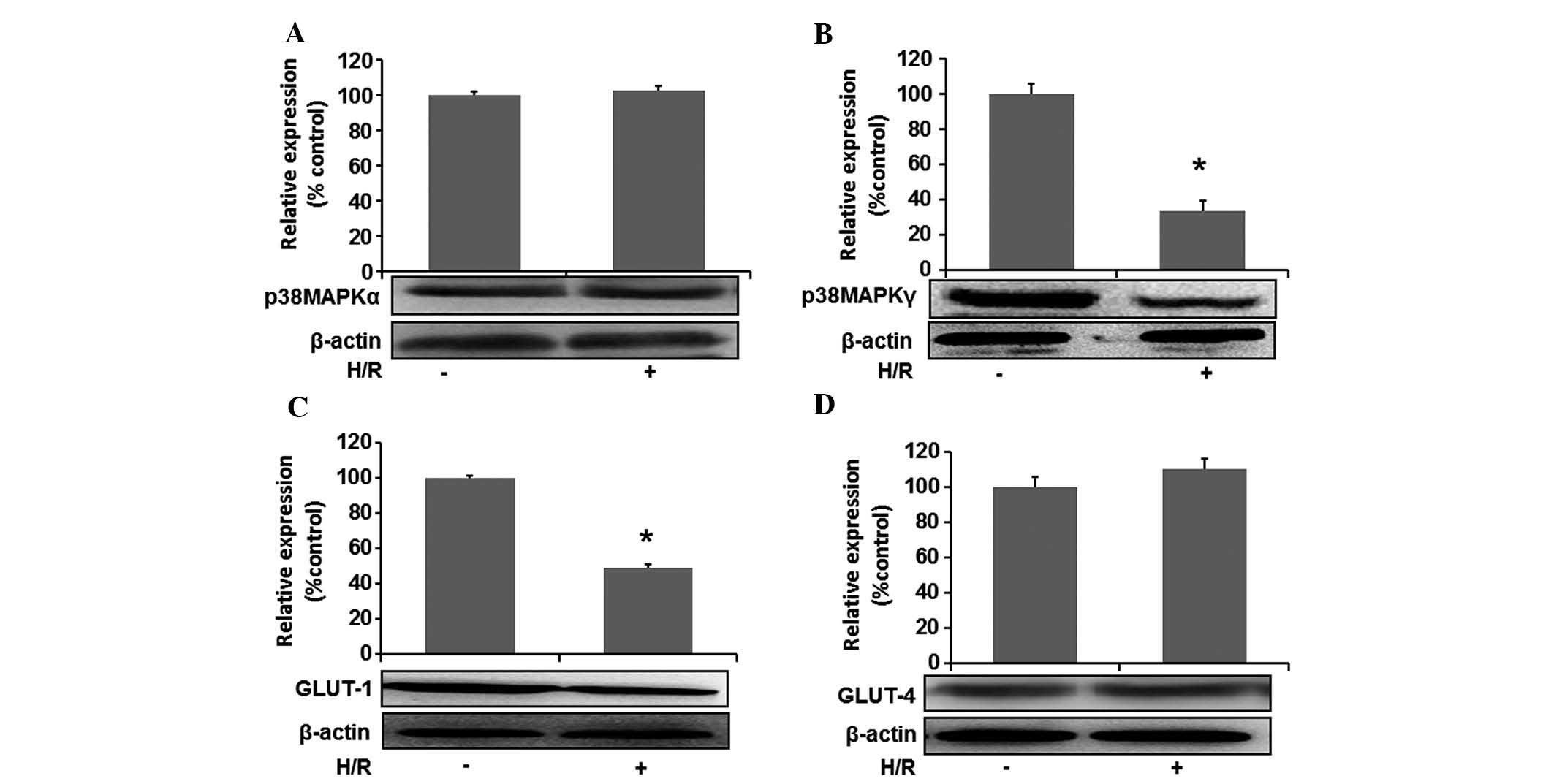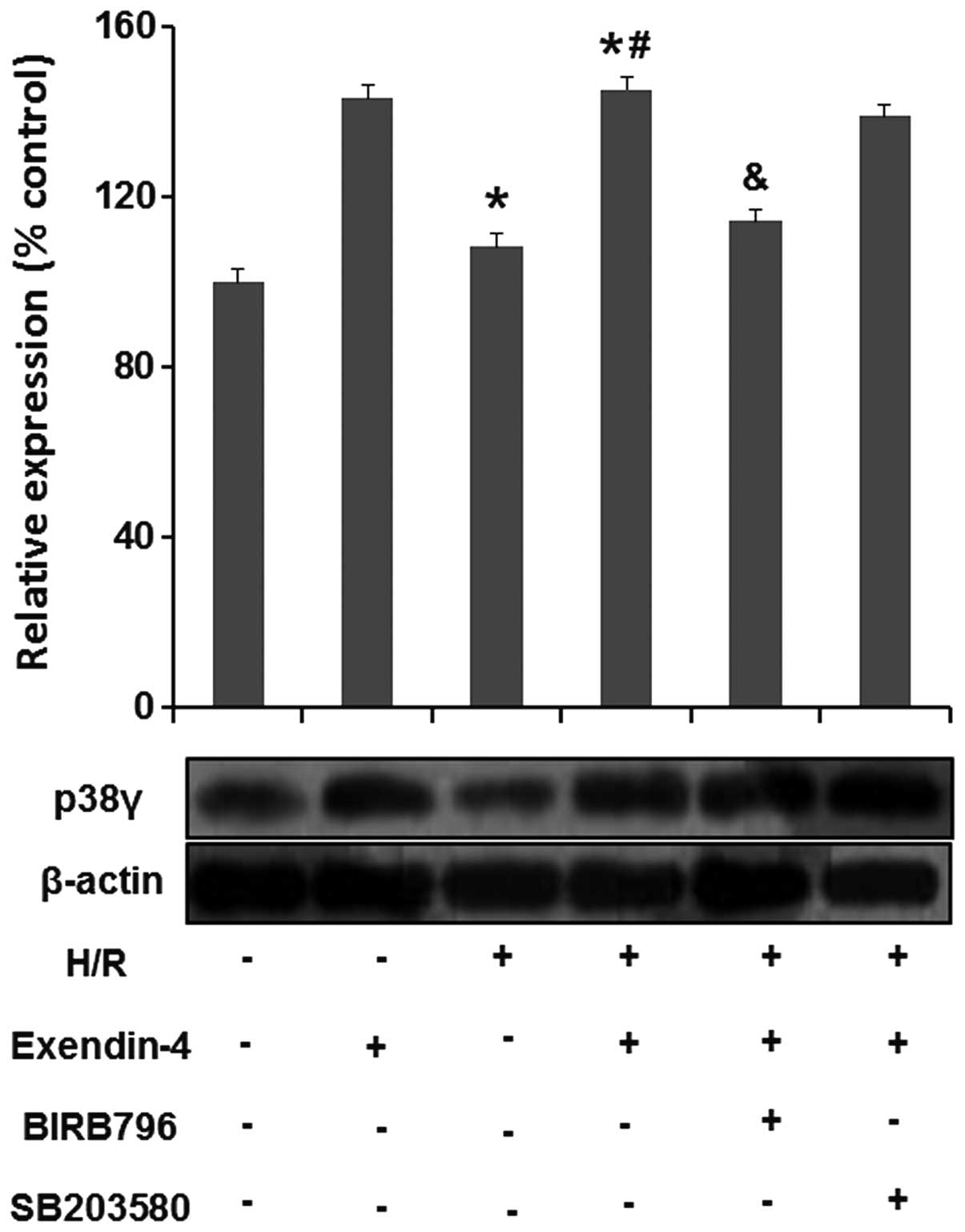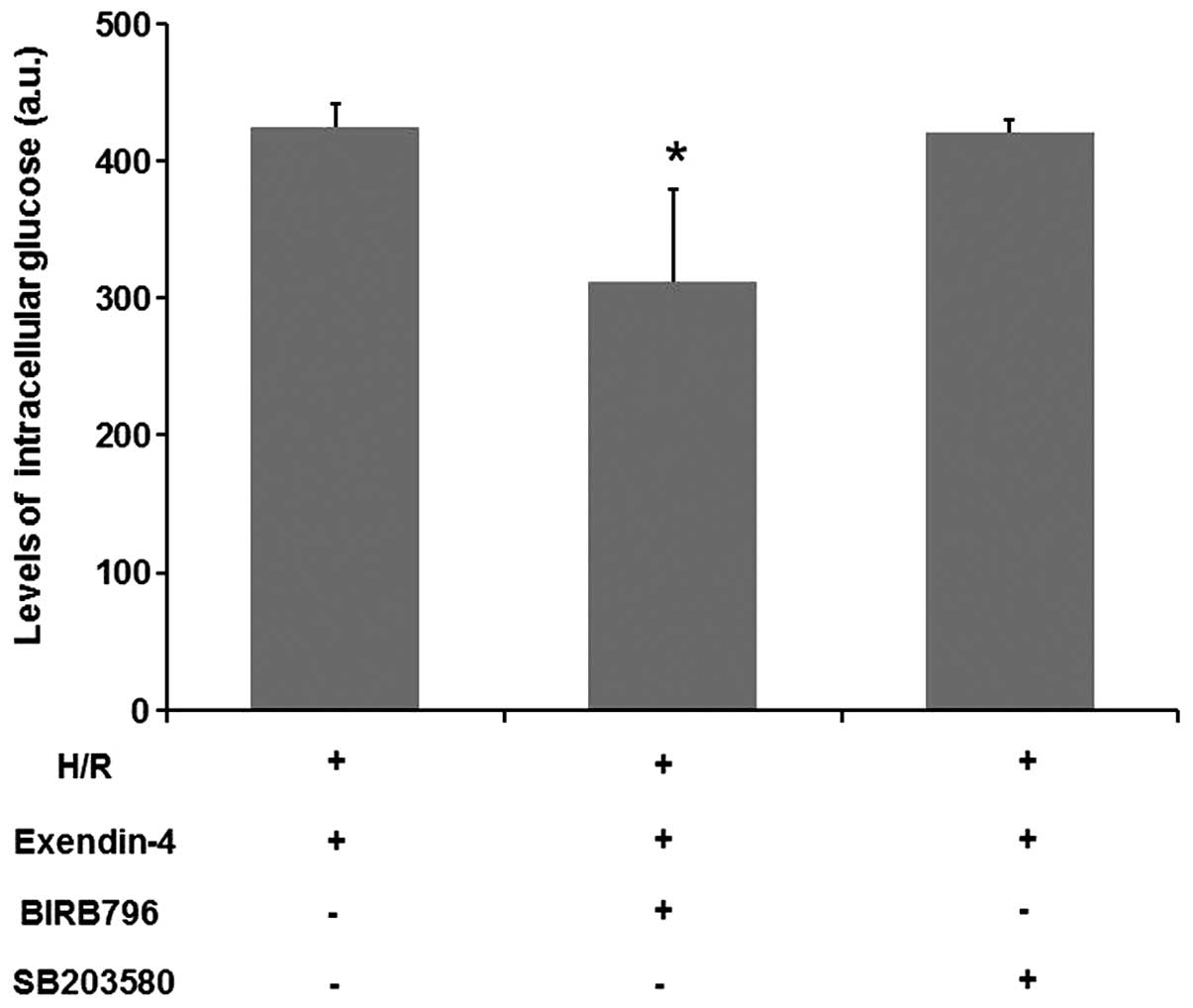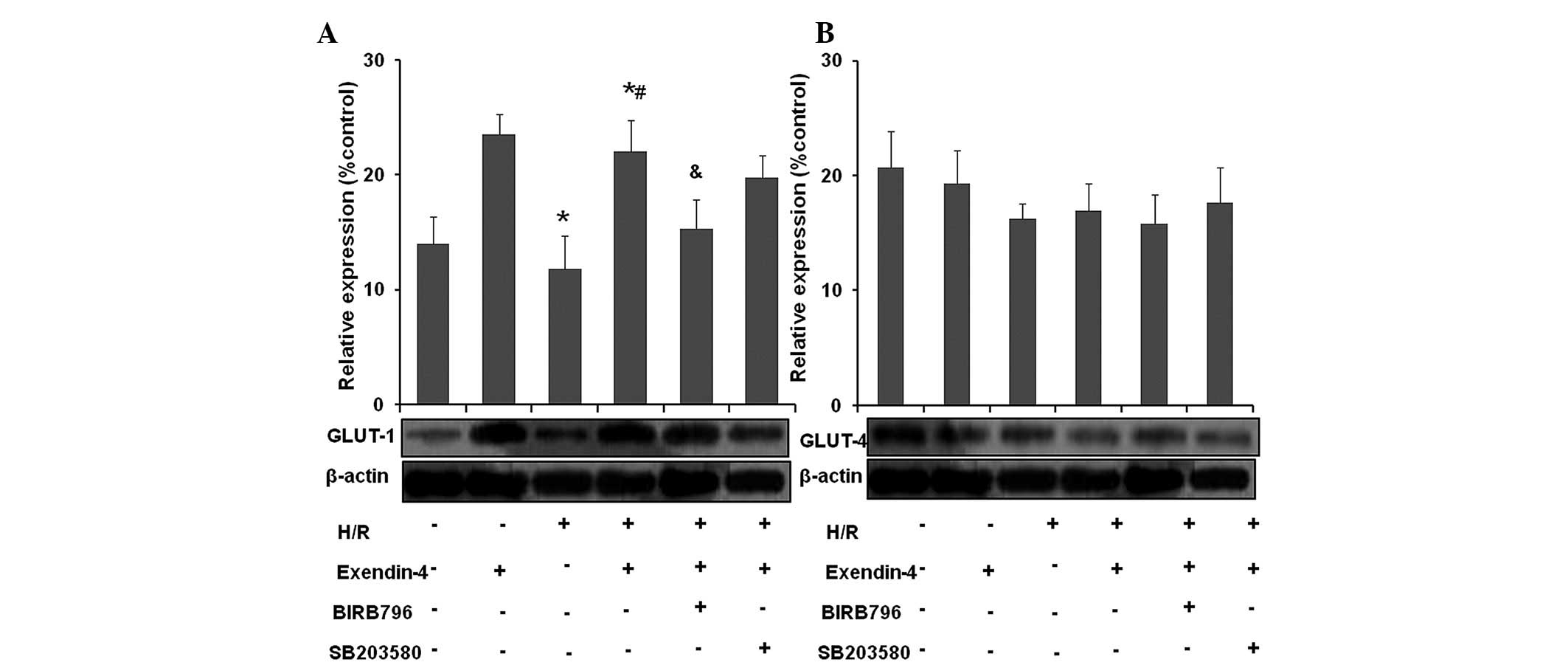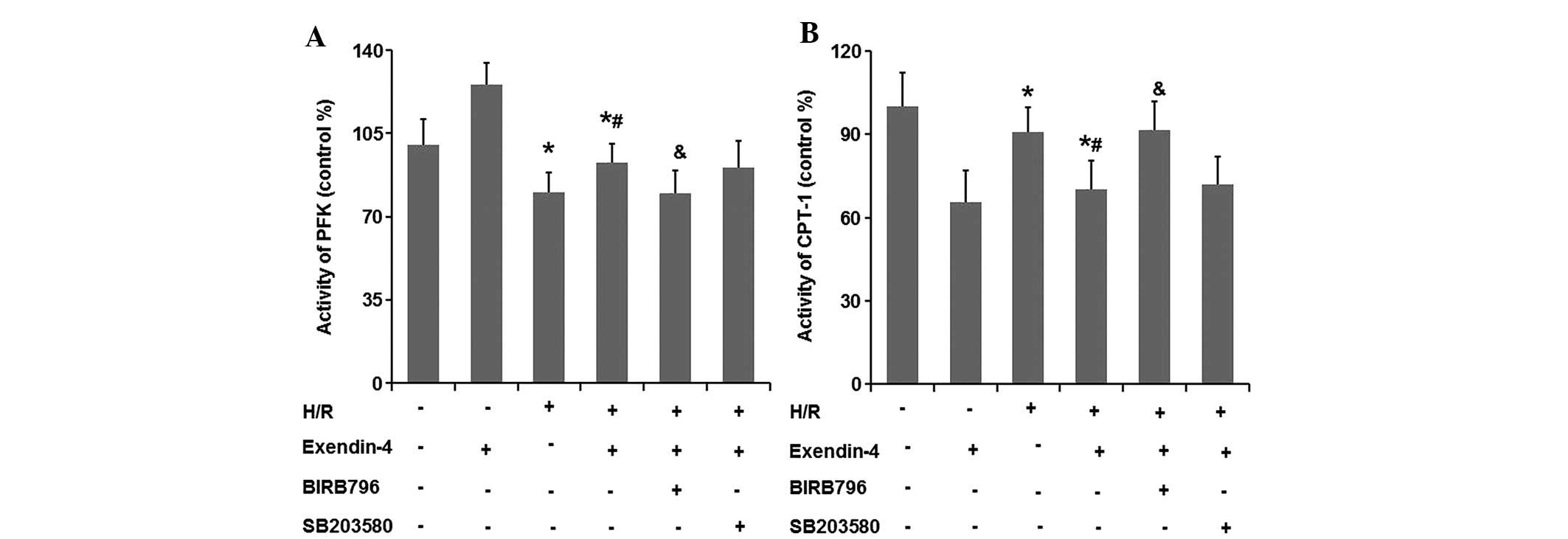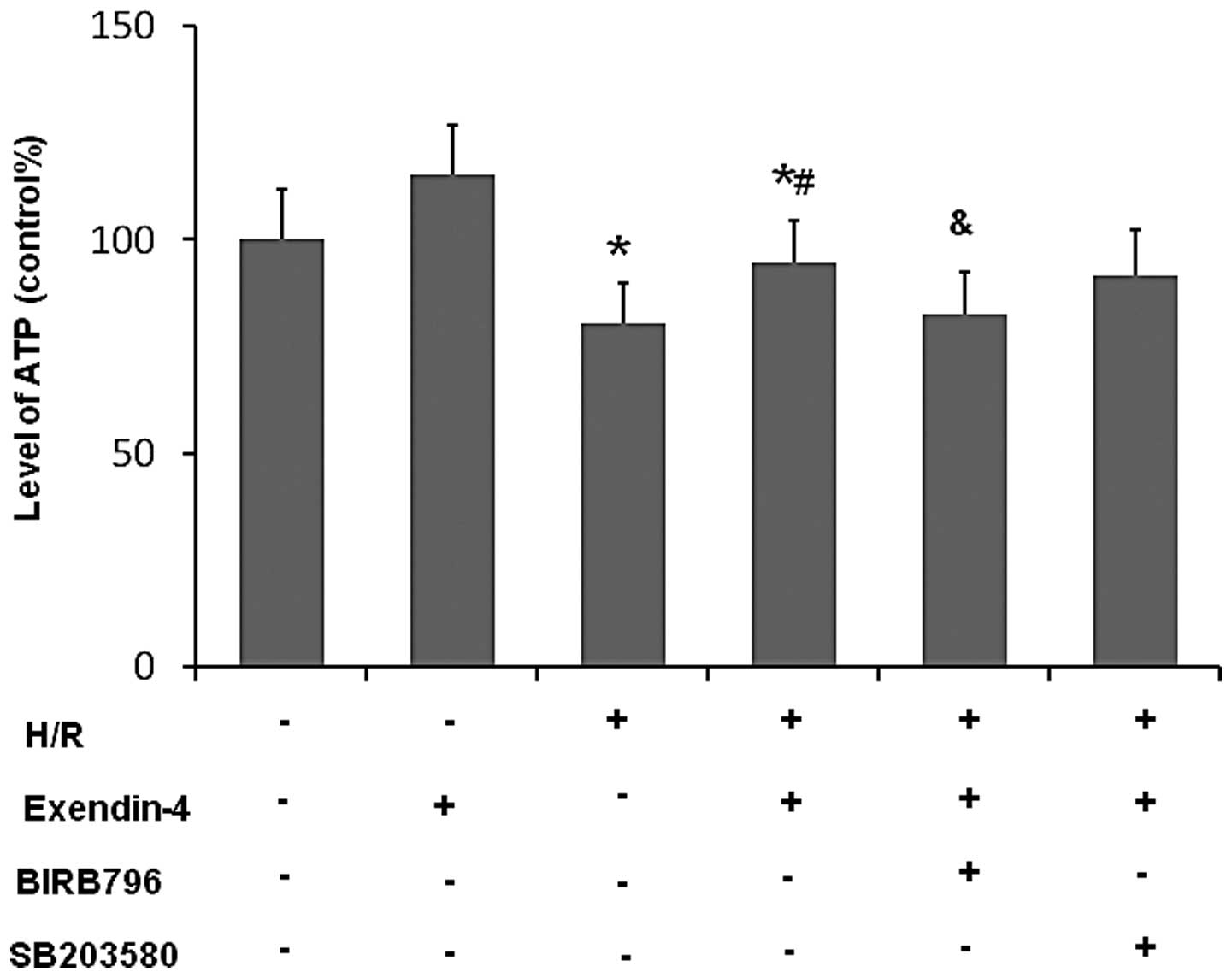Protective effects of extendin‑4 on hypoxia/reoxygenation‑induced injury in H9c2 cells
Corrigendum in: /10.3892/mmr.2020.11159
- Authors:
- Published online on: April 24, 2015 https://doi.org/10.3892/mmr.2015.3682
- Pages: 3007-3016
Abstract
Introduction
When cardiomyocytes suffer from ischemic or hypoxic insults, the metabolic balance between glucose and fatty acid shifts to fatty acid oxidation, which aggravates the oxygen deficiency, as fatty acid consumes 10% more oxygen than glucose when an equal amount of adenosine triphosphate (ATP) is produced. Furthermore, increased fatty acid oxidation has been reported to induce mitochondrial uncoupling and increase oxidative stress (1,2). Normalizing metabolic imbalances, which are underlying causes of metabolic disorders, has been one of the targets for the treatment of ischemic heart diseases (3).
Glucagon-like peptide-1 (GLP-1), an incretion hormone, has been confirmed to potently promote insulin secretion and down-regulate glucose levels, which gives it a high potential to be used for the treatment of diabetes patients (4–7). However, its half life time is too short for it to be used in clinic (8). Therefore, analogues with significantly longer half-lives, such as exendine-4, have been developed and used in the clinic (9). Over the last decade, a growing body of evidence has demonstrated that GLP-1 and its analogues can exert protective effects on cardiomyocytes with ischemic or hypoxic damage (10–13); however, the exact mechanism is still elusive. Studies have reported that GLP-1 and its analogues increased the glucose uptake and helped to preserve the cardiac function in animal experiments and clinical trials (13,14). However, whether exendine-4 can contribute to restore the metabolic balance between glucose oxygen and fatty acid oxidation and therefore ameliorate the energy imbalance of hypoxia-induced cardiomyocytes has not been fully elucidated.
The aim of the present study was to determine whether exendin-4 is capable of reducing hypoxia/reoxygenation (H/R)-induced injury by normalizing the energy imbalance in cardiomyocytes. For this, a model of hypoxia/reoxygenation (H/R)-induced injury in H9c2 cardiomyocyte cells was established to assess the effects of exendin-4 on glucose uptake. The possible mechanism involved in this process was also investigated by assessing the activation of the p38 mitogen-activated protein kinase (MAPK) signaling pathway.
Materials and methods
Cell culture and hypoxia/reoxygenation treatment
H9c2 cells (Chinese Academy of Medical Sciences, Shanghai, China) were cultured in Dulbecco’s modified Eagle’s medium: Nutrient Mixture F-12 (DMEM/F12; Thermo Fisher Scientific, Waltham, MA, USA) supplemented with 10% fetal bovine serum (FBS; Invitrogen Life Technologies, Carlsbad, CA, USA), in 50-cm2 flasks in a humidified atmosphere of 5% CO2 at 37°C. The hypoxia/reoxygenation (H/R) model was established according to the methods described in previous studies with certain modifications (15). Briefly, when cells were cultured to 80% confluence in appropriate culture, they were subjected to hypoxia using DMEM/F12 without FBS and glucose in a hypoxia chamber (Forma 370; Thermo Fisher Scientifiic, Waltham, MA, USA) saturated with a gas mixture (95% N2 and 5% CO2) at 37°C. Following hypoxia treatment, the culture medium was replaced with fresh normal medium and the plate was placed in the humidified atmosphere of 5% CO2 to receive reoxygenation treatment. Different treatment times of hypoxia and reoxygenation were used to determine the optimal time for establishing the H/R model. Exendine-4 (Eli Lilly, Indianapolis, IN, USA), a GLP-1 analogue, was added to the culture medium for 30 min before they were subjected to hypoxia. In certain cases, inhibitors of p38MAPK, BIRB796 (1 μM) and SB203580 (5 μM) (Santa Cruz Biotechnology Inc., Dallas, TX, USA), were added to the culture medium 10 min prior to treatment with exendine-4.
Cell counting kit (CCK)-8 assay
Cell viability was assessed using the CCK-8 (Beyotime Institute of Biotechnology, Haimen, China) as described previously with certain modifications (16). The H9c2 cells (1×104) were seeded in 96-well microplates. Folowing H/R treatment (4/2, 6/3, 12/4, 14/5, 16/6 and 22/10 h) with or without exendine-4 (0, 50, 100, 200 and 300 nM, respectively), cells were cultured in fresh medium and 10 μl CCK-8 solution. The plates were then incubated in the humidified atmosphere of 5% CO2 at 37°C for 2 h. Finally, the optical density (OD) values at 470 nm were measured using a microplate reader (Multiskan MK33; Thermolab systems, Helsinki, Finland).
Measurement of myocardial glucose uptake
Myocardial glucose uptake was measured as the levels of intracellular 2-(N-(7-nitrobenz-2-oxa-1,3-diazol-4-yl)amino)-2-deoxyglu-cose (2-NBDG). 2-NBDG is a fluorescent labeled glucose analogue, which can be transported into the cytoplasm from the culture medium but cannot be metabolized further (17). Following incubation for 30 min, cells were rinsed with phosphate-buffered saline (PBS) and the fluorescent density was measured by a microplate reader (721D; Pudong Shanghai Physical Optical Instrument Factory, Shanghai, China) at an excitation wavelength (Ex.) of 488 nm/and an emission wavelength (Em.) of 520 nm. The total fluorescent density of every well was adjusted by the OD values of cell viability from the CCK-8 cell counting kit assay, which was performed as soon as the measurement of the fluorescent density was finished. The actual intracellular glucose levels were defined as the ratio of fluorescent density (arbitrary unit, a.u.) to the OD values of cell viability.
Colorimetry
The levels of lactate dehydrogenase (LDH) in the culture medium, as well as the activity of phosphofructoki-nase-1 (PFK-1) and carnitine palmitoyltransferase-1 (CPT-1) in the H9c2 cells were determined by colorimetry. The experiment was performed using commercially available kits according to the manufacturer’s instructions. The LDH Activty Colorimetric assay was purchased from Jiancheng Bioengineering Institute (Nanjing, China). The PFK-1 and CPT-1 Activty Colorimetric assays were purchased from Sigma-Aldrich (St. Louis, MO, USA). Briefly, culture medium was separated by centrifugation at 1,600 x g for 10 min at 4°C and then used for the measurement of the LDH levels. The H9c2 cells were collected and lysed with cell lysis buffer (Beyotime Institute of Biotechnology, Haimen, China). The cell lysates were then centrifuged at 1,600 x g for 10 min at 4°C and the supernatants of were collected for the detection of PFK-1 and CPT-1 activity. Following incubation with the reagents included in the kits, the absorbance values at 340 and 420 nm were measured continuously using a spectrophotometer (Multiskan MK33, Thermolab systems, Helsinki, Finland). The LDH levels was expressed as U/l. The activity of PFK-1 and CPT-1 was defined as the fold-change in enzyme activity relative to that in the control group. The protein concentration was determined using the bicinchoninic acid (BCA) protein assay (Beyotime Institute of Biotechnology) (18).
ELISA assays
The levels of creatine kinase-MB (CK-MB) in the culture medium were measured using a CK-MB ELISA assay kit (R&D Systems, Minneapolis, MN, USA) according to the manufacturer’s instructions. Following the indicated treatments as mentioned above, the culture medium were collected and centrifuged at 1,600 x g for 10 min at 4°C. The supernatants were collected for the detection of CK-MB. The supernatants were then incubated with the reagents included in the kits. Finally, the absorbance values were measured using a microplate reader (Multiskan MK33; Thermolab systems, Helsinki, Finland) at 450 nm. The CK-MB levels were expressed as U/l.
Flow cytometry
Cell apoptosis was examined using flow cytometry. H9c2 cells (2×104/100 μl) were seeded in six-well plates for 72 h. After the indicated treatments mentioned above, cells were collected, washed with cold PBS and resuspended at a density of 1×106/ml. Cells (500 μl) were mixed with 5 μl Annexin V-fluorescein isothiocyanate (Beyotime Institute of Biotechnology) and 10 μl propidium iodide (PI, 20 mg/ml; Beyotime Institute of Biotechnology) and incubated for 20 min in the dark at room temperature. Flow cytometric analysis (Ex. 488 nm/Em. 530 nm) was performed with a FACSCalibur cell sorter (BD Biosciences, Franklin Lakes, NJ, USA). Flow cytometric data were analyzed using CellQuest™ version 4.5 software (BD Biosciences).
ATP measurement
Cellular ATP content was measured using the ATP bioluminescent assay kit (Beyotime Institute of Biotechnology) according to the manufacturer’s instructions. For each experiment, cells were briefly washed two times with ice-cold PBS, resuspended in 100 μl Tris-EDTA buffer (100 mM Tris-HCl and 4 mM EDTA, pH 7.55; Beyotime Institute of Biotechnology) and then incubated for 3 min at 100°C. Following centrifugation at 10,000 x g for 2 min, supernatants were extracted and 10 μl of them plus 40 μl ATP assay buffer was added into the wells of a microplate, which had each been filled with 50 μl ATP reaction mix (ATP assay buffer, 48.5 μl; ATP probe, 0.2 μl; ATP converter, 2.0 μl; and Development mix, 2.0 μl). The microplate was covered with aluminium foil and incubated at 37°C for 30 min prior to measuring the OD at Ex. 535 nm/Em. 587 nm using a microplate reader (721D; Pudong Shanghai Physical Optical Instrument Factory).
Western blot analysis
Membrane proteins of H9c2 cells were extracted from cell lysates using a membrane protein extraction kit (Beyotime Institute of Biotechnology, Haimen, China). The protein concentration was determined using the BCA assay (Beyotime Institute of Biotechnology). Protein samples (40 or 20 μg) were mixed with 2X SDS sample loading buffer (Beyotime Institute of Biotechnology) and then separated on a 12% polyacrylamide gel and blotted on a nitrocellulose membrane (Beyotime Institute of Biotechnology). Blots were blocked with 5% skimmed milk, followed by incubation with antibodies specific to p38MAPKα (1:100; cat. no. sc-398305; Santa Cruz Biotechnology Inc.), p38MAPKγ (1:100; cat. no. sc-366013; Santa Cruz Biotechnology Inc.), GLUT-1 (1:100; cat. no. ab652; Abcam Trading Company Ltd., Shanghai, China), GLUT-4 (1:100; cat. no. 7796-3; Epitomics Biotechnology Inc., Burlingame, CA, USA) or β-actin (1:1,000; cat. no. sc-130656; Santa Cruz Biotechnology Inc,). Blots were then incubated at room temperature for 30 min with secondary antibody (1:1,000; cat. no. zm0441; Zhongshan Goldenbridge Biotechnology Corporation) and an enhanced chemiluminescence detection system (Bio-Rad, Hercules, CA, USA) was used for visualization. The grey value was measured using Quantity One version 4.5 software (Bio-Rad).
Statistical analysis
SPSS 17.0 software (SPSS, Inc., Chicago, IL, USA) was used for statistical analysis. Values are expressed as the mean ± standard deviation. Differences between groups were determined by one-way analysis of variance followed Dunnett’s post-hoc test and P<0.05 was considered to indicate a statistically significant difference between values.
Results
Exentin-4 increases the viability of H9c2 cells subjected to H/R
Following H/R for various times (4/2, 6/3, 12/4, 14/5, 16/6 and 22/10 h), H9c2 cell viability was assessed using a CCK-8 kit. As shown in Fig. 1A, cell viability decreased in an H/R time-dependent manner. Cell viability after 4/2 h and 6/3 h H/R decreased to 95.21 and 86.90%, respectively, compared with that in the control group (P<0.05), while 12/4, 14/5, 16/6 and 22/10 h H/R further decreased the cell viability to 64.99, 61.44, 53.65 and 35.52% of the control, respectively (P<0.05). As 12/4 h was the shortest H/R time that caused a significant difference in cell viability (P<0.05), these conditions were then selected to investigate the potential effects of exentin-4 on cardiomyocyte protection.
H9c2 cells were pre-treated with exentin-4 (0, 50, 100, 200 and 300 nM, respectively) for 30 min prior to H/R treatment (12/4 h). Fig. 1B shows that treatment with exendin-4 increased H9c2 cell viability even at the lowest concentration of 50 nM. The percentage of cells surviving the H/R insult was increased by exendin-4 in a dose-dependent manner between 0 and 200 nM, and the cell viability reached a peak in the presence of 200 nM exendin-4. When the concentration of exendin-4 was further increased to 300 nM, the percentage of surviving cells did not increase correspondingly, but was slightly decreased; however, this change was not significant. These results strongly suggested that exendin-4 exerted a protective effect against H/R injury of H9c2 cardiomyocyte cells. Exendin-4 achieved the best efficiency to protect cell viability at a concentration of 200 nM. Therefore, the concentration of 200 nM was selected for the treatment of H9c2 cells in the following experiment.
Exentin-4 reduces LDH and CK-MB release in H9c2 cells subjected to H/R
As LDH and CK-MB release are two acknowledged markers for cardiomyocyte injury, these proteins were examined in the culture medium (Fig. 2A and B). LDH and CK-MB release significantly increased in the H/R group compared to that in the control group (P<0.05), while pre-treatment with 200 nM exendin-4 significantly decreased LDH and CK-MB release induced by H/R (P<0.05). These results strongly suggested that exendin-4 exerted a protective effect against the H/R injury of H9c2 cardiomyocyte cells.
Exendin-4 attenuates H/R-induced apoptosis of H9c2 cells
The present study investigated the effect of exendin-4 on the H/R-induced apoptosis in cultured H9c2 cells using flow cytometry (Fig. 3A and B). The results of the flow cytometric analysis suggested that the number of apoptotic cells in the H/R treatment group was higher than that in the control group (P<0.05). Pre-treatment with 200 nM exendin-4 decreased the amount of apoptotic cells in comparison to that in the H/R group (P<0.05), which suggested that exendin-4 attenuated H/R-induced apoptosis of H9c2 cells.
Exendin-4 enhances glucose uptake in H/R-injured H9c2 cells
An increase of glucose uptake in cardiomyocytes is beneficial in protecting the heart against ischemic injury (19). To explore the possible mechanisms involved in the protection of cardiomyocytes by exendin-4, intracellular glucose levels were determined. As Fig. 4 shows, the glucose uptake was significantly decreased in the H/R group compared with that in the control group (P<0.05). As compared with the H/R group, pre-treatment with exendin-4 (200 nM) increased the glucose uptake of cells (P<0.05). These results indicated that exendin-4 enhanced glucose uptake in H/R-injured H9c2 cells.
H/R decreases intracellular expression of p38MAPKγ and translocation of GLUT1 in H9c2 cells
To study the role of p38MAPK and GLUT in H/R-induced injury of cardiomyocytes, changes in the protein expression of p38MAPKα and p38MAPKγ as well as translocation of GLUT1 and GLUT4 were detected by western blot analysis. Fig. 5A and B shows that the expression of p38MAPKγ in the H/R group was lower than that in the control group (P<0.05), while no significant changes in p38MAPKα levels were found (P>0.05).
With regard to the effects of H/R on GLUT, it was demonstrated that H/R reduced GLUT-1 translocation from the cytoplasm to the membrane as compared with that in the control group (P<0.05), while the translocation of GLUT-4 was not significantly decreased (P>0.05) (Fig. 5C and D). The results indicated that p38MAPKγ and GLUT-1 may have an important protective role in H/R-injured cardiomyocytes.
Exendin-4 increases the expression of p38MAPKγ in H9c2-cells subjected to H/R
To determine the effects of exendin-4 on p38MAPKγ in H/R-injured cardiomyocytes, the p38MAPKγ expression in H9c2 cells was assessed using western blot analysis (Fig. 6). p38MAPKγ expression was significantly reduced in the H/R group compared with that in the control group (P<0.05), while it was markedly enhanced following pre-treatment with 200 nM exendin-4 (P<0.05). To further study the role of p38MAPKγ in the effects of exendin-4 on p38MAPK in H/R-injured cardiomyocytes, two different p38MAPK inhibitors, BIRB796 and SB203580, were used. As shown in Fig. 6, the effects of exendin-4 on p38MAPKγ were inhibited by BIRB796 (P<0.05), while SB203580 did not show any such effect (P>0.05). These results suggested that p38MAPKγ may have an important role in exendin-4 mediated protection of cardiomyocytes against H/R injury.
p38MAPK inhibitor BIRB796 abolishes the effect of exendin-4 on glucose uptake in H9c2 cells
To further confirm the role of p38MAPKγ in the effect of exendin-4 on cardiomyocytes, the effect of the p38MAPK inhibitors BIRB796 and SB203580 on the glucose uptake in H9c2 cells was assessed. As shown in Fig. 7, the effects of exendin-4 on the glucose uptake were inhibited by BIRB796 (P<0.05), while SB203580 did not show any such inhibitory function (P>0.05). These results suggested that p38MAPKγ may have an important role in exendin-4-mediated glucose uptake.
Exendin-4 increases the translocation of GLUT-1 in H9c2 cells subjected to H/R
H/R reduced GLUT-1 translocation from the cytoplasm to the membrane as compared with that in the control group (Fig. 8A and B; P<0.05), while the translocation of GLUT-4 was not significantly decreased (P>0.05). Pre-treatment with 200 nM exendin-4 increased GLUT-1 translocation from the cytoplasm to the membrane (P<0.05) in comparison to that in the H/R group, while the translocation of GLUT-4 was not significantly decreased (P>0.05). These results indicated that exendin-4 increased the translocation of GLUT-1 but not GLUT-4 in H/R-injured cardiomyocytes.
By contrast, translocation of GLUT-1 in the presence of exendin-4 was not significantly affected by SB203580 following H/R (P>0.05), while GLUT-1 translocation was abolished by BIRB796 compared with that in the exendin-4 + H/R group (P<0.05). No significant effect of SB203580 or BIRB796 on GLUT-4 translocation was identified (P>0.05). These results suggested that p38MAPKγ may have an important role in exendin-4-mediated GLUT-1 trans-location in H9c2 cells subjected to H/R.
Exendin-4 enhances the activity of PFK-1 and attenuates that of CPT-1 in H/R-damaged H9c2 cells
To investigate the effects of exendin-4 on the metabolic balance between glucose oxygen and fatty acid oxidation, the activity of PFK-1 and CPT-1 was examined. As shown in Fig. 9A and B, the activity of PFK-1, the key regulator of glycolysis, was significantly decreased in the H/R group compared with that in the control group (P<0.05). Furthermore, the activity of the rate-limiting enzyme of fatty acid oxidation, CPT-1, was significantly increased in the H/R group compared with that in the control group (P<0.05). Pre-treatment with 200 nM exendin-4 increased the activity of PFK-1 and decreased that of CPT-1 in comparison to that in the H/R group (P<0.05), which suggested that exendin-4 enhanced glycolysis in H9c2 cells subjected to H/R.
The effects of exendin-4 on the activities of PKF-1 and CPT-1 were not significantly affected by SB203580 (P>0.05); however, they were abolished by the use of BIRB796 (P<0.05). These results suggested that p38MAPKγ may have an important role in exendin-4-mediated glycolysis in H9c2 cells subjected to H/R.
Exendin-4 increases ATP production in H/R-damaged H9c2 cells
As shown in Fig. 10, the levels of ATP were significantly decreased in the H/R group compared with those in the control group (P<0.05), while the levels of ATP in the exendin-4 group were significantly increased compared with those in the H/R group (P<0.05). This result suggested that exendin-4 enhanced the production of ATP in H9c2 cells subjected to H/R. However, BIRB796 treatment significantly inhibited the effect of exendine-4 on ATP levels in H9c2 cells following H/R (P<0.05), while SB203580 did not have any significant effect. These results indicated that exendin-4-induced production of ATP in H9c2 cells subjected to H/R may be mediated via p38MAPKγ.
Discussion
The main finding of the present study was that the GLP-1 analogue exendin-4 reduced H/R-induced cell injury and enhanced glucose uptake as well as glycolysis of cardiomyocytes by activating the p38MAPK signaling pathway in a H9c2 cell model. Importantly, p38MAPKγ, one subunit of p38MAPK, may have the most significant role in this process.
Effects of GLP-1 and its analogues on ischemic cardiomyocytes in animal experiments or clinic trials have been reported in previous studies, most of which supported its beneficial effects (10,20,21). In line with previous studies, the present study found that exendin-4 reduced H/R-induced cell injury, as evidenced by increases in cell viability, decreases in levels of LDH and CK-MB, and a reduction in cardiomyocyte apoptosis.
Under normal physiological conditions, cardiomyocytes prefer fatty acid as the substrate of metabolism to maintain their function (19). However, the reduced availability of oxygen during low-flow ischemia makes fatty acid oxidation unfavorable, as it aggravates oxygen deficiency due to larger stochiometric amounts of oxygen required for ATP production compared with glycolysis (22), another pathway for ATP production in cardiomyocytes. A study has demonstrated that enhancement of glycolysis through diverse mechanisms or pharmacological interventions was able to delay and prevent ischemic damage (3). Therefore, reducing fatty acid oxidation and shifting the metabolic balance to glycolysis has been a focus in the field of ischemic heart disease treatment (23). In the present study, it was found that exendin-4 optimized the metabolism in H9c2 cells by enhancing glucose uptake, increasing PFK-1 activity and decreasing CPT-1 activity. PFK-1 and CPT-1 are the rate-limiting enzymes in the biological processes of glycolysis and fatty acid β-oxidation, respectively, and changes in their activity therefore reflect the changes of the two main pathways of energy production (24,25). In addition, the present study found that exendin-4 treatment significantly increased the levels of ATP in H9c2 cells subjected to H/R. These results strongly indicated that exendin-4 adjusted the metabolic imbalance in H9c2 cells subjected to H/R.
A recent in vivo study reported that exendin-4 failed to increase glucose uptake and glucose oxidation in rat hearts (26); however, the heart metabolism is profoundly different from that of cardiomyocytes in vitro, which may explain why the results contradicted those of the present study. According to previous studies, the effects of GLP-1 and its analogues on glucose uptake were more definite in ischemic cardiac myocytes than those in non-ischemic ones (27). In addition, whether glucose metabolism disorders exist at baseline, may also affect the modification of glucose metabolism by receptor agonists, such as GLP-1 (21,28).
MAPKs are key signal transmitters in animals and humans and p38MAPK is one of their sub-families (29). The p38MAPK signaling pathway has an important role in apoptosis, secretion of cytokines, transcription regulation and resistance to ischemic damage (30–32). The role of p38MAPK in the action of GLP-1 receptor agonists and modification of glucose transportation has been rarely reported, particularly in models of H/R-induced injury, while there are discrepancies between the available studies with regards to the role of p38MAPK and its subunits in the function of GLP-1 and its analogues (27,33,34). Further study of the role of p38MAPK and its subunits in the function of GLP-1 and its analogues is required. In the present study, H/R was found to decrease intracellular expression of p38MAPKγ and translocation of GLUT-1 in H9c2 cells. The results indicated that p38MAPK and GLUT may have an important protective role in H/R-injured cardiomyocytes.
It has been reported that the use of BIRB796 could decrease the activity of the four P38MAPK subunits by almost 100%, while SB203582 failed to exert an obvious effect on the activities of γ and δ (35,36). Furthermore, the amount of p38MAPKβ and p38MAPKδ was only 10.6% and 0.08% of that of p38MAPKα (37). Previous studies as well as the present study have only focused on the α and γ subunits of p38MAPK. The present study found that BIRB796 treatment inhibited the effects of exendin-4, including the enhancement of the glucose uptake, increasing the production of ATP, increasing PFK-1 activity and decreasing CPT-1 activity, while SB203580 treatment did not exert any inhibitory effects. Considering the fact that the distribution of the β and δ subunit significantly lower than that of the α subunit (only accounting for 10.6 and 0.08% of that of α, respectively, while γ is similar to α (37), it is assumed that the function of exendin-4 in H/R-injured cells is mainly mediated via the p38MAPKγ subunit. These results clearly demonstrated that the p38MAPK signaling pathway, particularly p38MAPKγ, may have an important role in exendin-4-mediated glycolysis in H9c2 cells subjected to H/R. The results of the present study differed from those of Bhashyam et al (34), which indicated that GLP-1 increases myocardial glucose uptake cia p38MAPK in conscious dogs with dilated cardiomyopathy. Zhao et al (27) reported that the total expression of p38MAPK was increased in normal and postischemic isolated rat hearts after treatment with GLP-1; however, information on changes in the levels of p38MAPK subunits were not available. The results of the present study contributed to the knowledge in the field of p38MAPK involvement in the modification of glucose uptake following H/R; however, as previous studies using various non-uniform models and drugs have produced conflicting results, this mechanism requires further elucidation.
GLUT-1 and GLUT-4 have a critical role in glucose uptake in cardiomyocytes. Enhanced myocardial glucose uptake by upregulation of GLUT-1 and GLUT-4 may be one of the underlying mechanisms to explain the beneficial effect of GLP-1 and its analogues on reducing myocardial injury (16,38). In the present study, in accordance with the identified glucose uptake enhancement in H9c2 cells subjected to H/R, if was found that exendin-4 increased the translocation of GLUT-1 but not that of GLUT-4, which was abolished by BIRB796. These results indicated that exendin-4 enhanced glucose uptake by upregulation of GLUT-1. The p38MAPK signaling pathway, in particular the p38MAPKγ subunit, may have the most important role in this process.
The role of GLUTs in the action of GLP-1 and its analogues has also been reported in several studies, but the results were contradictory among those reports (27,39–41). Arnés et al (41) found that exendin-4 increased the expression of GLUT-4 in rat muscles and that of GLUT-2 in rat livers. However, in this type 2 diabetes mellitus model, an increase of GLUT-4 was not observed. Another study using a myocardial infarction-induced heart failure model showed that GLP-1 and exenatides analogue AC3174 exerted a cardioprotective function; however, this was not associated with the translocation of GLUT-1 or GLUT-4 (40). Furthermore, Zhao et al (27) reported that GLP-1 increased GLUT-1 and GLUT-4 translocation following ischemic treatment, while Bhashyam et al (34) found that only GLUT-1 translocation was involved in a dog model of dilated cardiomyopathy, which was consistent with the results of the present study. Based on all of these findings, it remains difficult to draw a solid conclusion with regard to the role of GLUTs in the action of GLP-1 and its analogues. However, it can be concluded that the modification of GLUTs by GLP-1 or its analogues is different to that by insulin.
In conclusion, the present study demonstrated for the first time, to the best of our knowledge, that GLP-1 analogue exendin-4 improved the energy metabolism of cardiomyocytes by activating the p38MAPK signaling pathway in H9c2 cells subjected to H/R treatment. Importantly, p38MAPKγ, one subunit of p38MAPK, was indicated to have an important role in this process. Of course, further studies in vivo are required to fully evaluate the cardioprotective effects of exendin-4 and to determine the exact underlying molecular mechanism.
Acknowledgments
This work was supported by the National Natural Science Fund (grant no. 81100196), the Natural Science Foundation Project of Chongqing Science & Technology Commission (grant no. CSTC, 2011BB5133), Chongqing Municipal Health Bureau fund (grant nos. 2010-1-07, 2012-2-125 and ZY20132124) and the National Key Clinical Specialties Construction Program of China (grant no. 2011-170). The authors would like to thank Mr. Jianyong Wu and Mr. Dezhang Zhao (Institute of Life Sciences, Chongqing Medical University) for their excellent technical support with the flow cytometric analysis.
References
|
Hütter JF and Soboll S: Role of fatty acid metabolites in the development of myocardial ischemic damage. Int J Biochem. 24:399–403. 1992. View Article : Google Scholar : PubMed/NCBI | |
|
Gambert S, Vergely C, Filomenko R, Moreau D, Bettaieb A, Opie LH and Rochette L: Adverse effects of free fatty acid associated with increased oxidative stress in postischemic isolated rat hearts. Mol Cell Biochem. 283:147–152. 2006. View Article : Google Scholar : PubMed/NCBI | |
|
Grynberg A: Effectors of fatty acid oxidation reduction: Promising new anti-ischaemic agents. Curr Pharm Des. 11:489–509. 2005. View Article : Google Scholar : PubMed/NCBI | |
|
Avogaro A: Cardioprotective effects of glucagon-like peptide-1: Preclinical and clinical data. G Ital Cardiol (Rome). 12(Suppl 2): 17–24. 2011.In Italian. | |
|
Otto-Buczkowska E: Glucagon and glucagon-like peptides the role in control glucose homeostasis. Part I. Pediatr Endocrinol Diabetes Metab. 17:215–221. 2011.In Polish. | |
|
Gallwitz B: Anorexigenic effects of GLP-1 and its analogues. Handb Exp Pharmacol. 209:185–207. 2012.PubMed/NCBI | |
|
Quintanilla-García C and Zúñiga-Guajardo S: The incretin effect and type 2 diabetes. Rev Med Inst Mex Seguro Soc. 48:509–520. 2010.In Spanish. | |
|
Lindamood CA and Taylor JR: Emerging new therapies for the treatment of type 2 diabetes mellitus: Glucagon-like peptide-1 receptor agonists. Clin Ther. Feb 3–2015.Epub ahead of print. View Article : Google Scholar : PubMed/NCBI | |
|
Harris KB and McCarty DJ: Efficacy and tolerability of glucagon-like peptide-1 receptor agonists in patients with type 2 diabetes mellitus. Ther Adv Endocrinol Metab. 6:3–18. 2015. View Article : Google Scholar : PubMed/NCBI | |
|
Bao W, Aravindhan K, Alsaid H, Chendrimada T, Szapacs M, Citerone DR, Harpel MR, Willette RN, Lepore JJ and Jucker BM: Albiglutide, a long lasting glucagon-like peptide-1 analog, protects the rat heart against ischemia/reperfusion injury: Evidence for improving cardiac metabolic efficiency. PLoS One. 6:e235702011. View Article : Google Scholar : PubMed/NCBI | |
|
Bose AK, Mocanu MM, Carr RD, Brand CL and Yellon DM: Glucagon-like peptide 1 can directly protect the heart against ischemia/reperfusion injury. Diabetes. 54:146–151. 2005. View Article : Google Scholar | |
|
Bose AK, Mocanu MM, Carr RD and Yellon DM: Glucagon like peptide-1 is protective against myocardial ischemia/reperfusion injury when given either as a preconditioning mimetic or at reperfusion in an isolated rat heart model. Cardiovasc Drugs Ther. 19:9–11. 2005. View Article : Google Scholar : PubMed/NCBI | |
|
Read PA, Khan FZ and Dutka DP: Cardioprotection against ischaemia induced by dobutamine stress using glucagon-like peptide-1 in patients with coronary artery disease. Heart. 98:408–413. 2012. View Article : Google Scholar | |
|
Read PA, Hoole SP, White PA, Khan FZ, O’Sullivan M, West NE and Dutka DP: A pilot study to assess whether glucagon-like peptide-1 protects the heart from ischemic dysfunction and attenuates stunning after coronary balloon occlusion in humans. Circ Cardiovasc Interv. 4:266–272. 2011. View Article : Google Scholar : PubMed/NCBI | |
|
Phong WY, Lin W, Rao SP, Dick T, Alonso S and Pethe K: Characterization of phosphofructokinase activity in Mycobacterium tuberculosis reveals that a functional glycolytic carbon flow is necessary to limit the accumulation of toxic metabolic intermediates under hypoxia. PLoS One. 8:e560372013. View Article : Google Scholar : PubMed/NCBI | |
|
Idrovo JP, Yang WL, Nicastro J, Coppa GF and Wang P: Stimulation of carnitine palmitoyltransferase 1 improves renal function and attenuates tissue damage after ischemia/reperfusion. J Surg Res. 177:157–164. 2012. View Article : Google Scholar : PubMed/NCBI | |
|
Rajaram N, Frees AE, Fontanella AN, Zhong J, Hansen K, Dewhirst MW and Ramanujam N: Delivery rate affects uptake of a fluorescent glucose analog in murine metastatic breast cancer. PLoS One. 8:e765242013. View Article : Google Scholar : PubMed/NCBI | |
|
Lee J and Chang JH: Facile and high-efficient immobilization of histidinetagged multimeric protein G on magnetic nanoparticles. Nanoscale Res Lett. 9:6642014. View Article : Google Scholar | |
|
Ji L, Zhang X, Liu W, et al: AMPK-regulated and Akt-dependent enhancement of glucose uptake is essential in ischemic preconditioning-alleviated reperfusion injury. PLoS One. 8:e699102013. View Article : Google Scholar : PubMed/NCBI | |
|
Moberly SP, Berwick ZC, Kohr M, Svendsen M, Mather KJ and Tune JD: Intracoronary glucagon-like peptide 1 preferentially augments glucose uptake in ischemic myocardium independent of changes in coronary flow. Exp Biol Med (Maywood). 237:334–342. 2012. View Article : Google Scholar | |
|
Gejl M, Søndergaard HM, Stecher C, Bibby BM, Møller N, Bøtker HE, Hansen SB, Gjedde A, Rungby J and Brock B: Exenatide alters myocardial glucose transport and uptake depending on insulin resistance and increases myocardial blood flow in patients with type 2 diabetes. J Clin Endocrinol Metab. 97:E1165–E1169. 2012. View Article : Google Scholar : PubMed/NCBI | |
|
Tani M and Neely JR: Role of intracellular Na+ in Ca2+ overload and depressed recovery of ventricular function of reperfused ischemic rat hearts. Possible involvement of H+-Na+ and Na+-Ca2+ exchange. Circ Res. 65:1045–1056. 1989. View Article : Google Scholar : PubMed/NCBI | |
|
Ferrari R, Pepi P, Ferrari F, et al: Metabolic derangement in ischemic heart disease and its therapeutic control. Am J Cardiol. 82:2K–13K. 1998. View Article : Google Scholar : PubMed/NCBI | |
|
Mor I, Cheung EC and Vousden KH: Control of glycolysis through regulation of PFK1: Old friends and recent additions. Cold Spring Harb Symp Quant Biol. 76:211–216. 2011. View Article : Google Scholar : PubMed/NCBI | |
|
Aoi W, Naito Y and Yoshikawa T: Potential role of oxidative protein modification in energy metabolism in exercise. Subcell Biochem. 77:175–187. 2014.PubMed/NCBI | |
|
Nguyen TD, Shingu Y, Amorim PA, Schwarzer M and Doenst T: Glucagon-like peptide-1 reduces contractile function and fails to boost glucose utilization in normal hearts in the presence of fatty acids. Int J Cardiol. 168:4085–4092. 2013. View Article : Google Scholar : PubMed/NCBI | |
|
Zhao T, Parikh P, Bhashyam S, Bolukoglu H, Poornima I, Shen YT and Shannon RP: Direct effects of glucagon-like peptide-1 on myocardial contractility and glucose uptake in normal and postischemic isolated rat hearts. J Pharmacol Exp Ther. 317:1106–1113. 2006. View Article : Google Scholar : PubMed/NCBI | |
|
Moberly SP, Mather KJ, Berwick ZC, Owen MK, Goodwill AG, Casalini ED, Hutchins GD, Green MA, Ng Y, Considine RV, et al: Impaired cardiometabolic responses to glucagon-like peptide 1 in obesity and type 2 diabetes mellitus. Basic Res Cardiol. 108:3652013. View Article : Google Scholar : PubMed/NCBI | |
|
Cuenda A and Rousseau S: p38 MAP-kinases pathway regulation, function and role in human diseases. Biochim Biophys Acta. 1773:1358–1375. 2007. View Article : Google Scholar : PubMed/NCBI | |
|
Erdogdu O, Eriksson L, Xu H, Sjöholm A, Zhang Q and Nyström T: Exendin-4 protects endothelial cells from lipoapoptosis by PKA, PI3K, eNOS, p38 MAPK, and JNK pathways. J Mol Endocrinol. 50:229–241. 2013. View Article : Google Scholar : PubMed/NCBI | |
|
Xu H, Li HL, Niu ZY, Li GZ, Cao J and Jiang YD: Involvement of p38 MAPK pathway in GLP-1-induced inhibition of apoptosis in human umbilical vein endothelial cells. Sheng Li Xue Bao. 64:444–448. 2012.In Chinese. PubMed/NCBI | |
|
Kawasaki Y, Harashima S, Sasaki M, Mukai E, Nakamura Y, Harada N, Toyoda K, Hamasaki A, Yamane S, Yamada C, et al: Exendin-4 protects pancreatic beta cells from the cytotoxic effect of rapamycin by inhibiting JNK and p38 phosphorylation. Horm Metab Res. 42:311–317. 2010. View Article : Google Scholar : PubMed/NCBI | |
|
Ho RC, Alcazar O, Fujii N, Hirshman MF and Goodyear LJ: p38gamma MAPK regulation of glucose transporter expression and glucose uptake in L6 myotubes and mouse skeletal muscle. Am J Physiol Regul Integr Comp Physiol. 286:R342–R349. 2004. View Article : Google Scholar | |
|
Bhashyam S, Fields AV, Patterson B, Testani JM, Chen L, Shen YT and Shannon RP: Glucagon-like peptide-1 increases myocardial glucose uptake via p38alpha MAP kinasemediated, nitric oxide-dependent mechanisms in conscious dogs with dilated cardiomyopathy. Circ Heart Fail. 3:512–521. 2010. View Article : Google Scholar : PubMed/NCBI | |
|
Kuma Y, Sabio G, Bain J, Shpiro N, Márquez R and Cuenda A: BIRB796 inhibits all p38 MAPK isoforms in vitro and in vivo. J Biol Chem. 280:19472–19479. 2005. View Article : Google Scholar : PubMed/NCBI | |
|
Caverzasio J and Manen D: Essential role of Wnt3a-mediated activation of mitogen-activated protein kinase p38 for the stimulation of alkaline phosphatase activity and matrix mineralization in C3H10T1/2 mesenchymal cells. Endocrinology. 148:5323–5330. 2007. View Article : Google Scholar : PubMed/NCBI | |
|
Dingar D, Merlen C, Grandy S, Gillis MA, Villeneuve LR, Mamarbachi AM, Fiset C and Allen BG: Effect of pressure overload-induced hypertrophy on the expression and localization of p38 MAP kinase isoforms in the mouse heart. Cell Signal. 22:1634–1644. 2010. View Article : Google Scholar : PubMed/NCBI | |
|
Huisamen B, Genade S and Lochner A: Signalling pathways activated by glucagon-like peptide-1 (7–36) amide in the rat heart and their role in protection against ischaemia. Cardiovasc J Afr. 19:77–83. 2008.PubMed/NCBI | |
|
Vyas AK, Yang KC, Woo D, Tzekov A, Kovacs A, Jay PY and Hruz PW: Exenatide improves glucose homeostasis and prolongs survival in a murine model of dilated cardiomyopathy. PLoS One. 6:e171782011. View Article : Google Scholar : PubMed/NCBI | |
|
Liu Q, Anderson C, Broyde A, Polizzi C, Fernandez R, Baron A and Parkes DG: Glucagon-like peptide-1 and the exenatide analogue AC3174 improve cardiac function, cardiac remodeling, and survival in rats with chronic heart failure. Cardiovasc Diabetol. 9:762010. View Article : Google Scholar : PubMed/NCBI | |
|
Arnés L, Moreno P, Nuche-Berenguer B, Valverde I and Villanueva-Peñacarrillo ML: Effect of exendin-4 treatment upon glucose uptake parameters in rat liver and muscle, in normal and type 2 diabetic state. Regul Pept. 153:88–92. 2009. View Article : Google Scholar |





